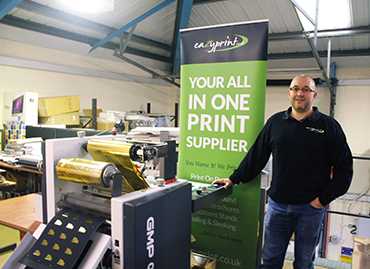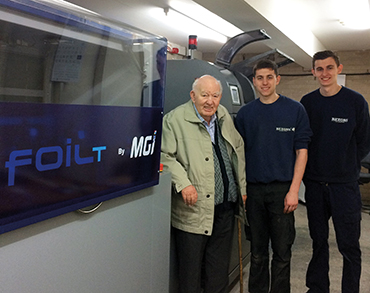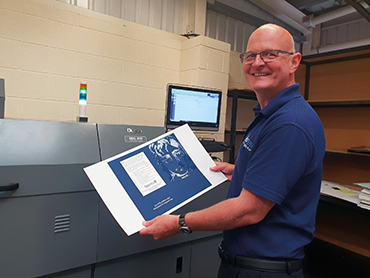“Printers’ customers want to stand out from the crowd and the printers themselves also want to stand out from their competition in terms of what they are able to offer customers,” says Alex North, head of digital marketing at Duplo International.
It may be a relatively new market, but according to Lynn Kolevsohn, marketing director at Scodix, it’s a rapidly growing niche – particularly in the digital print arena. “In only a few years, it has become one of the major growth areas within the printing market, and it will have a major impact in the commercial, packaging (labels, folding cartons, corrugated) and publishing market [in the future],” says Kolevsohn. “The driving forces in each one of those segments are different, but they are all working on the same direction: major growth in this market.”
She points to recent research from InfoTrends, which found that 1.8 trillion colour pages digitally printed on an annual basis feature some sort of embellishment or enhancement. And in the next two years half of all print service providers questioned by the research company said that they are considering investing in digital print enhancement technology. The other key attraction of embellishment technology was also underlined in the InfoTrends research. It found that print buyers are very interested in digital print enhancement and they are willing to pay a little bit more for it.
“There are an awful lot of printers out there who send a lot of embellishment work out to a trade finisher and who would love to have this sort of technology and bring this work inhouse, but there isn’t a lot of money in commercial print because it has become a commodity, so you need machines that anybody in the print room can walk up to and use,” says North. “Machines like the Duplo DuSense mean that for a relatively small investment companies can charge a substantially higher price for this embellishment work.”
It is a view shared by Kolevsohn who says that one of the advantages of the company’s embellishment devices is that they give even small commercial printers the ability to bring in-house a wide range of print enhancement capabilities, such as foiling, spot UV and raised UV coating, in one easy-to-use system that can be operated by a single person. “This is changing this market, which in the past was [only open to] either trade finishers, or very big printers,” she says.
Although the core technology that is currently being sold by manufacturers of embellishment devices is fundamentally the same as it was years ago, today a growing number of equipment suppliers are producing machines that are capable of serving a much wider market base than ever before.
“We see a huge difference in the market [today] in terms of awareness and the need for embellishment,” says Kolevsohn. “If years ago, we had to educate the market of why embellishment and enhancement was needed, today we see a change, that the printers understand, that with the commercial printing market shrinking, printers and brands are looking for a differentiator.”
Embellishment technology gives them that differentiator, which is why print experts and suppliers of finishing equipment unanimously agree that this is set to be a significant growth area in the future.
Case study: Eazyprint.co.uk
Eazyprint.co.uk is an all-digital printer based in Kettering that focuses on high-quality, short-run work. The company runs an impressive array of Konica Minolta and HP presses and 95% of its work is done in-house – including finishing. “We’ve got guillotines, folding machines, saddle-stitchers, case-bound and book-binding machines,” says Daniel Prétòt, production manager at Eazyprint.co.uk. “Some of the machines we have more than one of.”

As is the case with its GMP Q-Topic 380 laminator on which it is able to produce a foil on toner process that GMP calls ‘Sleeking’. The firm took the UK’s first ever GMP Q-Topic 380 laminator in June 2015. Within two years the volume of work going through the machine was so high that Petrot decided to sign up for another one.
Before purchasing his first Q-Topic Prétòt says that he shopped around and looked at a number of different laminators. “At the time I think Vivid was really the only competitor,” he explains. “Caslon did make a laminator, but it was on a much smaller scale – it was an A4 desktop type machine which was no use to us really. The Matrix [manufactured by Vivid] was really good on lamination, but back then we felt the foils didn’t really tend to stick or adhere as well. However, GMP’s machine seemed to do the trick straight out of the box so we opted for that and we have stuck with it ever since.”
As it was the first machine in the country Prétòt says he wasn’t really able to test its capabilities before taking the plunge, but he had used desktop GMP laminators in the past and he had been impressed with how the manufacturer was able to get the lamination to stick to digital print – something that he says many manufacturers struggle with. He admits that taking a step into the unknown with an unproven piece of technology was a bit of a gamble and it took the company a while to get used to the new device.
“It’s not a case of you can just get the machine out of the box and you know how to use it straight away,” says Prétòt. “I would say it takes around six to nine months to really master what you can do on it. Even now we are still learning about what the machine is capable of and we have really pushed the boundaries and the limits on what you can do with it. We work closely with GMP and they probably call us for advice on the machine as much as we ring them.”
Prétòt adds the company spent a lot of time doing research and development work on the Q-Topic and in the next few months he intends to unveil a new use he has discovered the device is capable of undertaking that he is really excited about.
“What it has done for us is it has pushed us into a slightly different market, opened up lots of different avenues and as a result we have gone a little bit more upmarket and we are doing a lot more bespoke work,” he explains. “We are literally laminating and foiling every single day and probably for the majority of the day. It is rare that the machines are not turned on and being used for at least half a day.”
The devices are being kept so busy at the moment that Prétòt is weighing up purchasing a third one from GMP. “I highly rate the machines – otherwise we wouldn’t have bought the second one. Now we are looking to put a third one in or we might go with one of the bigger brothers. GMP do a Protopic, which can also cut and slit paper and laminate as it goes through, so we might get one of them, but we’d still keep the other two Q-Topics.”
Case study: Ernest Bexon & Co
Nottingham-based Ernest Bexon & Co was founded in the mid-1960s by Ernest Bexon, his son-in-law Michael Morris plus Morris’ brother Geoff. The family-run company is a trade printer and produces a wide range of printed collateral including books, booklets, magazines, boxes and cartons and business cards, all the way up to B1 format sheets.

Left to right: Michael Morris, his grandson Declan Morris and Ryan Morris
The company is a litho house, but in 2016 it decided to add another string to its bow. “We felt we needed a digital press as we were all litho and some of the runs we were being asked to quote on lent themselves to be printed digitally rather than litho,” explains Ryan Morris, digital machine manager/estimator, who is the great grandson of Ernest Bexon.
A couple of years prior to 2016 the company attended a number of different trade shows to research and weigh up all the options, but it eventually decided to plump for a MGI Meteor dry toner digital press complete with the French manufacturer’s Unlimited Colors inline digital hot foiling system – the Unlimited Colors name reflects the fact that after a standard silver or gold foil has been applied the digital four-colour process is added so it can sit on top of the foil, thus changing the foil to whatever colour is required.
“What we liked about the MGI compared to other machines was that it had an inline feeder, which could feed sheets up to 1,200mm long and up to 400gsm/micron, whereas other machines had trays” says Morris. “Also the machine seemed more robust and was more in the tradition of a litho press than a digital press. It has a vast gamma range with a separate system to match Pantone colours and the foiling unit was the something extra that we could use to open up new opportunities.”
He adds that the long sheet size complemented the company’s existing B1 offer so smaller runs could be switched across if needed and the fact that the machine didn’t come with a click charge was also attractive.
However, what really swung it for the company was the iFoil T foiling unit that can be fitted to new presses or retrofitted. Bexons was the first UK printer to sign for the new system and the company was really impressed when it saw what the set up could achieve.
“Once the samples from the iFoil unit were shown to us this certainly helped sell us the machine,” says Morris.
“We did plenty of tests on the straight digital press on a vast array of papers and then my dad, John Morris, went to France to see the iFoil in operation and we did more tests there.”
The digital press was installed prior to Drupa 2016 and the iFoil unit was fitted several weeks after the show ended. “In hindsight this was not the best option,” says Morris, who adds that it would have been better had both sections of the machine been delivered and installed at the same time.
Regardless of this minor quibble he says that “all in all we are happy with the machine. It has brought in digital jobs which we would have missed out on before and is opening new doors with its foiling capabilities”.
Case study: Flexpress
Flexpress managing director Steve Wenlock is a big believer that to grow a business you have to continue to invest in new equipment so that you can continually expand the range of products you can offer customers, which in the Leicester-based company’s case includes a wide range of businesses encompassing print management companies, graphic designers, copy centres and publishers.

True to his word earlier this year he splashed out on a new HP Indigo 12000 B2 digital press in a bid to win digital B2 work and support growth of the £2.5m-turnover company, which employs 23 members of staff. Prior to this investment Wenlock had been busy bolstering the company’s armoury of finishing kit, which includes the UK’s first Duplo iSaddle System stitcher, installed in 2014. Then last year Flexpress took delivery of the UK’s first Duplo DuSense DDC-810 ‘sensory coater’.
“We had been excited about the prospect of offering short-run spot UV for a while so when we were invited to the initial product launch by Duplo we were both intrigued and excited,” recalls Wenlock. “At the event we had the opportunity to assess its capabilities, see some test jobs and learn a little about its strengths and weaknesses.”
The timing of Duplo’s launch was fortuitous as Wenlock had been looking around the market for a coating solution for some time. “We had considered machines by Komfi, Autobond and, of course, Scodix, but we had dismissed each of them for one reason or another,” he says. “The Duplo machine fitted most, if not quite all, of our criteria. It offered a spectacular, high-quality effect, within a practical footprint at a price that we believed we could make work from a company we knew and trusted. It was 80%-plus right, whereas none of the others had got close to that.”
DuSense is the first digital spot varnishing device launched by Duplo. The compact machine can print clear UV spot varnish with the option of producing raised and textured finishes to resemble embossing. The machine can handle sheets of up to long B3 format and register the spot coating to pre-printed images. As soon as Wenlock saw what the device was capable of he was completely blown away.
“When you operate in a trade market, particularly with very capable and competitive rivals, you need to offer things that open doors and add value. People remember you for the things you do differently rather than the things you do the same so in this sense, it was a no-brainer,” he says.
Since installation, Wenlock says the DuSense has gained a “few new fans” every month, who have been won over by its capabilities. “At the same time it opens a few more doors, so in that sense it has certainly made us money,” he says. “More importantly, it makes our clients money as they can offer cost-effective, short-run, special-effect, spot UV to their clients.”
Flexpress was a beta tester for the device and as with any new technology launch there were a few early teething issues that were hard to foresee, but Wenlock says he had the utmost confidence in his supply partner, thanks to his company’s strong track record of working with Duplo in the past on previous technology launches.
“Both Duplo and ourselves have been through a learning curve with the machine, but despite this, we wouldn’t swap it and we wouldn’t backtrack on our decision,” adds Wenlock. “Of course we went out on a bit of a limb and put a lot of faith in Duplo, but throughout they have never let us down.”
SUPPLIER CONTACTS
Autobond 01773 530520 www.autobondlaminating.com
Caslon 01727 852211 www.caslon.co.uk
Duplo International 01932 263966 www.duplointernational.com/uk
Foliant (UK agent Intelligent Finishing Systems) 020 8997 8053 www.ifsl.uk.com, www.foliant.cz
GMP 01295 268833 www.gmpuk.co.uk
Intec Printing Solutions 01202 845960 www.intecprinters.com
Komfi (UK supplier Friedheim International) 01442 206100 www.friedheim.co.uk, www.komfieurope.com
MGI +33 145 210660 www.mgi-fr.com
Scodix +972 3903 3371 www.scodix.com
Vivid 03451 304050 www.vivid-online.com







